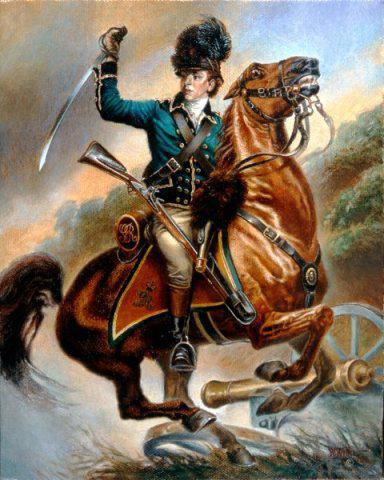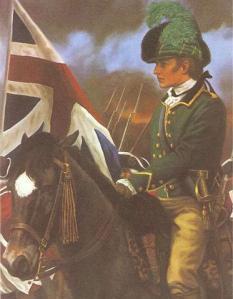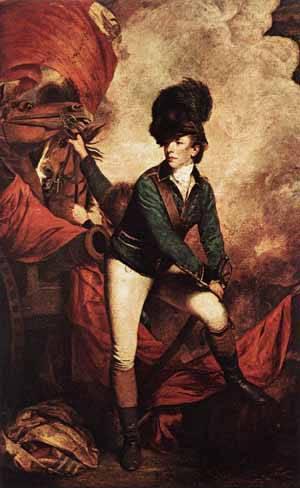Those who have read any of my books (written either as Emery Lee or as Victoria Vane) already know that I use a number of real historical characters in my stories, but history is also where I find inspiration for my fictional characters. In my prior post on the actress Mary Robinson, I mentioned that she had served greatly as a model for my character, Phoebe, the actress in my romantic comedy, A WILD NIGHT’S BRIDE , and that Mary Robinson was known for a long-term love affair with Banastre Tarleton, a British officer of considerable repute. Tarleton was truly a dashing figure in his time and served as a model for Colonale William Tavington in the motion picture THE PATRIOT. He was also the inspiration for my character Captain Hewett DeVere in THE VIRGIN HUNTRESS. A hero, a rake, and a politician, BANASTRE TARLETON is certainly worthy of a post in this blog.

The Victors Always Write the History
Although our history books often paint an entirely different picture of the American Revolution, it was in most respects the first American civil war. A war that began as a dispute between political parties – Tory and Whig which eventually resulted in one party (Tory) seeking aid from British troops, and the other (Whig)from France. Due primarily to English arrogance, blundering and ineptitude, we all know how it ended. To Loyalists it was war of dismal failures and lost opportunities, but the brief epoch of Cornwallis’ Southern Campaign under the command of Colonel Banastre Tarleton will ever stand out for its military skill, courage and endurance in the face of great odds.
Tarleton’s Legion: A Formidable Fighting Force
The story begins in the summer of 1778 with the miserably executed British campaign floundering and with France now coming out in the open to formally join the war. After losing Saratoga, the previous autumn, a new British commander, Sir Henry Clinton, is sent to America. Withdrawing to New York to salvage the mess, part of Clinton’s new war initiative is the formation of a number of elite fighting forces which would be better adapted to the conditions and tactics of the war in America. The first such unit was the Queen’s Rangers, under the command of a 26 year old English officer name John Graves Simcoe, but the most (in)famous would be the British Legion, later called Tarleton’s Legion after it’s intrepid commander.
 The son of a Liverpool, Merchant, Banastre Tarleton had left his study of law at Oxford in 1775 to volunteer in Cornwallis’ army. An ardent huntsman and a daring horseman, he had gained a commission in the British cavalry and at only twenty-three, was promoted (by merit) to Lieutenant Colonel of the British Legion. Always wanting to go beyond the routine of the soldier’s life, he came to be known for his speed, daring, and surprise. 1Like Simcoe, Lieutenant-Colonel Tarleton was chosen to head up an elite fighting force and served as the Legion’s first and only field commander from the beginning to the end of the war. By all accounts, British and American, his regiment was the best led, the most enduring, the most dashing, the most relentless, most successful of the British/Loyalist regiments, and most feared and hated by rebels.
The son of a Liverpool, Merchant, Banastre Tarleton had left his study of law at Oxford in 1775 to volunteer in Cornwallis’ army. An ardent huntsman and a daring horseman, he had gained a commission in the British cavalry and at only twenty-three, was promoted (by merit) to Lieutenant Colonel of the British Legion. Always wanting to go beyond the routine of the soldier’s life, he came to be known for his speed, daring, and surprise. 1Like Simcoe, Lieutenant-Colonel Tarleton was chosen to head up an elite fighting force and served as the Legion’s first and only field commander from the beginning to the end of the war. By all accounts, British and American, his regiment was the best led, the most enduring, the most dashing, the most relentless, most successful of the British/Loyalist regiments, and most feared and hated by rebels.
Eschewing the traditional red British uniform which made the soldiers perfect targets, the Legion were dressed in green to better blend into the landscape. The chosen uniform was much like that of Simcoe’s, consisting of a short green jacket with a black roll collar, white buckskin breeches, with black riding boots for the cavalry or long black gaiters for the infantry. The headgear was a black leather cap, hard and polished, and looking like a small round iron pot, with a glazed leather peak in front. (Tarleton’s portrait by Sir Joshua Reynolds, now hanging in the Governor’s Mansion at Richmond, Virginia, shows him wearing a large bunch of black plumes on his helmet, and possibly this was general amongst the officers.) The dragoons were armed with sabre and pistol, the infantry carried a light musket with the usual cross-belts holding bayonet and cartridge-box.
Additionally, they were a unit of all arms – cavalry, infantry and artillery – a complete striking force in itself. The cavalry were trained how to move stealthily through woods. The infantry learned to run with the cavalry, holding on to the horses’ manes, and on the road they were trained in a mile-devouring quick step. Recruited to full strength, Tarleton’s Legion mustered a total of 606 officers and men, grouped in 5 companies of infantry and 6 companies of dragoons.
The day after Christmasn 1779, Tarleton’s Legion embarked with the rest of Cornwallis’ force for South Carolina but a terrible storm scattered the fleet and sank several of the ships. All the cavalry horses were lost, and was the heavy artillery destined for the siege of Charleston. The army disembarked in February, 1780, near Charleston. Tarleton immediately set about remounting his cavalry, gathering horses by purchase, by requisition, and by capture from mounted rebel troops. Once his dragoons were re-equipped they entered upon a long campaign, that spearheaded the British army. The numbers of Tarleton’s Legion varied with the fortunes of war- at it’s maximum, swelled by the influx of Loyalist recruits from South and North Carolina, the Legion numbered close on 2,000. At other times, decimated by battle and by fever in the unhealthy river country of the South, it mustered no more than 150 men, horse and foot.
Cornwallis saw victory on May 11th, 1780 with Charleston surrendering its entire rebel garrison of 6,000. The news, after so many dismal failures, was received with utmost rejoicing in England and in royalist New York. But under the false impression that the southern colonists would flock to the king’s colors, Clinton returned the bulk of his forces to New York, leaving Cornwallis with 4,000 regulars and about 2,000 Loyalists who were cut off from the coast by districts populated with ardent rebels. With his 6,000 troops, and two or three batteries of field artillery, Cornwallis’ troops were expected to perform a miracle by holding Georgia, putting down the rebels of South Carolina, and protecting the loyalists of North Carolina.
As the advance guard of the British army, Tarleton’s Legion, frequently fought whole battles by themselves, and took a prominent part in all. They faced bands of expert guerillas like Morgan, Marion and Sumter, troops raised and equipped by the rebel legislatures of South and North Carolina, as well as a stream of Continental regulars moving down from Virginia and Maryland as well as a mountain range full of wild frontiersmen, bred to warfare, well armed and frequently well mounted, and possessed of a longstanding hatred for the Loyalist low-country planters.
The country was veined with rivers with few or no bridges and the few roads were little better than cow paths, choking the troops with dust in the burning summer and miring them in the mud in the rainy season. Tarleton was also compelled to rely upon the already devastated and hostile country for supplies. The common ration was corn pone and hominy, occasionally augmented with pork or beef; but often no more than what could be scavenged from gardens and orchards. The hard-ridden Legion horses perished by scores and had to be replaced with whatever poor screws they could come by.
Keeping his forces mobile and compact, Tarleton’s strategy was to move fast and strike hard, and so began a sixteen month campaign of grueling marches and desperate skirmishes over 1,300 miles from Charleston to the Chesapeake, against an enemy always better equipped and superior in number. Still, almost without exception Tarleton prevailed. In a charge by less than 200 Legion dragoons, Tarleton routed Sumter’s whole force and captured all his baggage and artillery and 1,000 stand of arms. At Waxhaw Tarleton’s Legion (following a march of 105 miles in 54 hours) destroyed a Virginian force under Buford which considerably out-numbered them. Even General Gates, the conqueror of Burgoyne, was no match. Marching south he was utterly defeated at Camden and “ran 80 miles in a day.” He was superseded by Nathaniel Greene, the general who stood next to Washington in the estimation of the rebels; but Greene could do no better, retreating all the way from South Carolina to the far side of Virginia.
On the other hand there was the utter rout at Cowpens where the Legion was thrust forward too boldly and cut to pieces by Morgan and his Virginians. At the end of that long fighting trek to the Chesapeake, the Legion infantry were marching barefoot with the whole corps in rags.
(NOTE: Despatch from Cornwallis to Clinton, dated Petersburg, Virginia, May 20, 1781 – “The Legion being in the utmost distress for want of arms, clothing, boots and indeed equipment of all kinds, I must beg that your excellency will be pleased to direct the inspector-general to forward a supply of every article with the utmost despatch.”)
In reaching the James River, Tarleton was detached on a raid across the state of Virginia, covering 400 miles in 15 days in the mid-summer heat. The fighting reputation of Tarleton’s Legion was such that only Continental regulars would face him in the open field, and whole regiments of militia often fled at the mere mention of his name.
Although Tarleton’s Legion is condemned by many historians for inhumanity, discipline always prevailed. When overtaken on the road by a group of local Virginians complaining of rape and robbery, Tarleton promptly ordered his troops to dismount and line up, so that the witnesses could pick out – these are Tarleton’s own words – “the villains who committed (these) atrocious outrages.” After which a sergeant and a dragoon were tried by court-martial and condemned to death.
Tarleton’s most famous exploit was on June 1st, 1781, when he and 250 of his troopers were ordered to “break up the Assembly at Charlottesville” where the Virginia legislature had convened. Tarleton and his troopers covered 70 miles in 24 hours, stopping twice to rest their horses and once to destroy a rebel wagon train on the road. Just as day was breaking they burst out of the dawn, scattered the town’s garrison (the rebel brigadier-general Scott was one of the casualties) and seized seven members of the Virginia Assembly, a member of the Continental Congress, and nearly caught the author of the Declaration of Independence himself; but Jefferson, watching from his hilltop home, saw the approach of the dragoons and fled out the back way, or as Tarleton drily put it, “provided for his personal liberty by a precipitate retreat.”
The end, however, was fast approaching with fever and harsh conditions taking equal toll with battles. Of the 6,000 troops who began the march from South Carolina only 1500 reached the Chesapeake, but the reinforcements were ill-prepared and inexperienced. Clinton had failed once more by doing too little, too late. The French fleet appeared in the Chesapeake, as Washington arrived with his Continental Army. In desperation, Cornwallis sent Tarleton’s Legion across the river to Gloucester to forge an escape but they encountered a squadron of French lancers. Tarleton was knocked off his horse and nearly captured but he escaped with the confidence that their stratagem had a reasonable chance of success. But it was not to be. Yorktown fell.
For fear of how his fiercest men would be treated by the Continental army, Cornwallis demanded under the terms of surrender, to send the Bonetta sloop-of-war to New York with his dispatches and with “Such soldiers as he may think proper to send.” On this ship were 241 officers and men of the British Legion, including Lieutenant-Colonel Tarleton. Soon after the surrender at Yorktown, Tarleton retuned to England with Major the Hon. George Hanger, fourth baron Coleraine, who had been second-in-command of the Legion Cavalry since May, 1780. Both of these man were enthusiastically embraced by the Prince of Wales (later George I) and his coterie.
LIFE AFTER THE WAR
 Considered a hero he was eventually promoted to the rank of General and elected to Parliament, knighted, and published his History but his pursuit of pleasure and his fifteen-year liaison with the author-actress, Mary Robinson, (click for my post on Mary Robinson) found him little favor with his constituents. After finally breaking with Mary Robinson at the age of forty-three he met and married Susan Priscilla Bertie on December 17, 1798. He lived a long life, but would never admit to any fault at Cowpens, saying he was outnumbered and received inadequate assistance from Cornwallis. He wondered. “how some unforeseen event” could “throw terror into the most disciplined soldiers”.
Considered a hero he was eventually promoted to the rank of General and elected to Parliament, knighted, and published his History but his pursuit of pleasure and his fifteen-year liaison with the author-actress, Mary Robinson, (click for my post on Mary Robinson) found him little favor with his constituents. After finally breaking with Mary Robinson at the age of forty-three he met and married Susan Priscilla Bertie on December 17, 1798. He lived a long life, but would never admit to any fault at Cowpens, saying he was outnumbered and received inadequate assistance from Cornwallis. He wondered. “how some unforeseen event” could “throw terror into the most disciplined soldiers”.
Tarleton wrote his “History of the Campaigns of 1780 and 1781″. In it, he sets forth objectively, and in detail, the story of the southern campaign, quoting in full the dispatches between Cornwallis and himself, and frequently the dispatches of the opposing American generals – documents captured in the field or copied after the war from American records.Banastre Tarleton is rarely recognized for his genius in strategy but his place in history goes far beyond his image as a “butcher”. He died childless on January 16, 1833, at the age of seventy-eight, was buried in Leintwardine Churchyard. He was one of the most controversial figures in the American Revolution, possibly remembered in America more than in his native country.
FURTHER READING:
“Tarleton’s Legion” by Thomas H. Raddall Written by Thomas H. Raddall in the late 1940s and published in the Collections of the Nova Scotia Historical Society in 1949. Information may be reproduced without permission for non-profit and/or educational use in accordance with the Canada Copyright Act.
THE GREEN DRAGOON: THE LIVES OF BANASTRE TARLETON& MARY ROBINSON
NOTE: For a considerable period of the campaign one of Clinton’s very finest regiments, the 17th Light Dragoons was attached to Tarleton and fought as part of the Legion. The 17th Light Dragoons were raised in England and placed on the regular establishment by a veteran officer of Wolfe’s army, and in honor of Wolfe the regiment’s chosen badge was a white skull on a black ground, with the motto “Death or Glory”. The uniform of this regiment was one of the most striking in the British army – tall brass helmets, each dangling a scarlet-dyed horse tail, each with a brass chin-strap; and tight red jackets, white breeches and long black jack-boots. This stiff and heavy uniform must have been highly uncomfortable in the hot southern sun; but it is said that when in the course of the campaign their uniforms became ragged and worn, the men of the 17th refused to discard them for the cooler green of the Legion, preferring to patch their own. **My character Hew DeVere was part of this elite fighting force.**
 EXCERPT FROM THE VIRGIN HUNTRESS by Victoria Vane
EXCERPT FROM THE VIRGIN HUNTRESS by Victoria Vane
LONDON’S HYDE PARK, 1783)
“Good morning ladies. ‘Tis a fine day for a gallop in the park.” Captain Hew beamed at Diana. Before Vesta could even return his salutation, he had his hands about Diana’s waist and was hoisting her onto her horse. He then held it in check while she settled her skirts, leaving Pratt to assist the incredulous Vesta. This time fury seared her rather than tears. By heavens she swore she would make him notice her if it was the last thing she ever did.
While Vesta tried her best to keep her mare in step with Hew and Diana, she had to keep circling her horse that jigged and frothed with nervous energy. Laughing and chatting about some race Hew once rode with Diana’s horse, they seemed to hardly take any heed of Vesta at all. How dare Aunt Di monopolize him like this!
“Are you aright wi’ the mare, miss?” Pratt asked her with solicitude not forthcoming from any other quarter.
“I am fine, Mr. Pratt. It’s just that she has been deprived of her normal gallop since leaving Yorkshire over a sennight ago. She is accustomed to frequent and vigorous exercise and can be a handful when denied.”
Although she could handle her mare just fine, she wondered how they all would feel if some horrible accident befell her. Vesta continued to fume. They would both be sorry then!
That was it! Vesta couldn’t believe the answer was right before her eyes. It only wanted the proper timing and a distraction for Pratt. Determined to put her plan into action, Vesta held back, letting the others ride further ahead. When Pratt’s head was turned, she saw her chance.
Whispering a prayer of supplication to her Mama, her ever-diligent guardian angel, Vesta plucked out her hat pin and tossed the riding cap to the ground. “Oh dear, Mr. Pratt,” she exclaimed. “I’ve lost my favorite hat!”
“Ne’er fret, my lady,” the elder jockey said, dropping to the ground with surprising agility. In that precious desperate moment when his back was turned, Vesta dropped her reins and spurred her mare.
Artemis, who never needed strong incentive to begin with, took off down Rotten Row like a bolt of dappled gray lightning. Vesta hung over her mare’s neck clutching the mane as if fearing for her very life but all the while whispering sweet endearments to her most cooperative conspirator. She knew it would be a mistake to look back. Instead, she urged and cooed and waited for the sound of thunder, for her knight in that lovely crimson crested helmet to come to her rescue and prayed fervently that her savior would not be the grizzled little Pratt.
When she saw Captain Hew’s big bay stallion gaining on the right, Vesta once more thanked her watchful Mama. Knowing he would try to grab the bridle to bring her horse to a halt, Vesta nudged the mare, urging more speed, with the cue of her left heel concealed by her voluminous and billowing petticoats. Her hair had fallen in a wind- whipped tangle about her face and neck; she felt the flush in her cheeks and her blood roaring with excitement. It was the most gloriously wild ride she’d ever had, and it was all she could do not to laugh aloud!
“Can you reach the reins,” Captain Hew cried, coming upon her.
“No. I’m afraid!” Vesta whimpered.
They approached the entrance to Kensington Gardens with its myriad hedgerows. “Hell and the devil!” he exclaimed, surging forth, but still unable to claim the bridle. “Trust me Vesta,” he demanded. “Let go of the horse!”
Trust him? He was a god among mortals. She would trust him if he said she could fly! And that’s exactly what she felt when he swept her off her horse and onto his own. Throwing her arms about him, Vesta burrowed into his neck and simply breathed in the heavenly essence of Captain Hewett DeVere.

